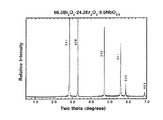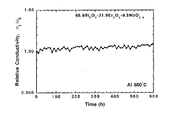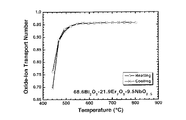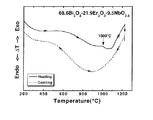JP4635254B2 - Oxide ion conductive material comprising bismuth / erbium / niobium oxide solid solution and method for producing the same - Google Patents
Oxide ion conductive material comprising bismuth / erbium / niobium oxide solid solution and method for producing the same Download PDFInfo
- Publication number
- JP4635254B2 JP4635254B2 JP2005329153A JP2005329153A JP4635254B2 JP 4635254 B2 JP4635254 B2 JP 4635254B2 JP 2005329153 A JP2005329153 A JP 2005329153A JP 2005329153 A JP2005329153 A JP 2005329153A JP 4635254 B2 JP4635254 B2 JP 4635254B2
- Authority
- JP
- Japan
- Prior art keywords
- oxide
- bismuth
- erbium
- solid solution
- niobium oxide
- Prior art date
- Legal status (The legal status is an assumption and is not a legal conclusion. Google has not performed a legal analysis and makes no representation as to the accuracy of the status listed.)
- Expired - Fee Related
Links
Images
Classifications
-
- Y—GENERAL TAGGING OF NEW TECHNOLOGICAL DEVELOPMENTS; GENERAL TAGGING OF CROSS-SECTIONAL TECHNOLOGIES SPANNING OVER SEVERAL SECTIONS OF THE IPC; TECHNICAL SUBJECTS COVERED BY FORMER USPC CROSS-REFERENCE ART COLLECTIONS [XRACs] AND DIGESTS
- Y02—TECHNOLOGIES OR APPLICATIONS FOR MITIGATION OR ADAPTATION AGAINST CLIMATE CHANGE
- Y02E—REDUCTION OF GREENHOUSE GAS [GHG] EMISSIONS, RELATED TO ENERGY GENERATION, TRANSMISSION OR DISTRIBUTION
- Y02E60/00—Enabling technologies; Technologies with a potential or indirect contribution to GHG emissions mitigation
- Y02E60/30—Hydrogen technology
- Y02E60/50—Fuel cells
-
- Y—GENERAL TAGGING OF NEW TECHNOLOGICAL DEVELOPMENTS; GENERAL TAGGING OF CROSS-SECTIONAL TECHNOLOGIES SPANNING OVER SEVERAL SECTIONS OF THE IPC; TECHNICAL SUBJECTS COVERED BY FORMER USPC CROSS-REFERENCE ART COLLECTIONS [XRACs] AND DIGESTS
- Y02—TECHNOLOGIES OR APPLICATIONS FOR MITIGATION OR ADAPTATION AGAINST CLIMATE CHANGE
- Y02P—CLIMATE CHANGE MITIGATION TECHNOLOGIES IN THE PRODUCTION OR PROCESSING OF GOODS
- Y02P70/00—Climate change mitigation technologies in the production process for final industrial or consumer products
- Y02P70/50—Manufacturing or production processes characterised by the final manufactured product
Landscapes
- Compositions Of Oxide Ceramics (AREA)
- Conductive Materials (AREA)
- Fuel Cell (AREA)
Description
本発明は、面心立方晶系の構造を有する一般式(Bi2O3)x(Er2O3)y(NbO2.5)z
(0.66<x<0.69、0.215<y<0.248、0.075<z<0.108、但し、x+y+z=1)で示さ
れるビスマス・エルビウム・ニオブ酸化物固溶体からなる酸化物イオン伝導材料及びその
製造方法に関する。
The present invention relates to compounds of the general formula having the structure of face-centered cubic (Bi 2 O 3) x ( Er 2 O 3) y (NbO 2.5) z
The present invention relates to an oxide ion conductive material comprising a bismuth-erbium-niobium oxide solid solution represented by (0.66 <x <0.69, 0.215 <y <0.248, 0.075 <z <0.108, where x + y + z = 1) and a method for producing the same.
従来、酸化ビスマスの高温安定相(δ-Bi2O3と命名されている)は酸素が25at%欠損
した蛍石型の面心立方晶系の構造をもち、高い酸化物イオン伝導を示す酸化物であること
が知られているが、その安定温度領域が730〜825℃と狭く、かつ還元され易い等の欠点を
有するために、他の酸化物を添加することにより、安定温度領域を室温付近まで低下させ
る安定化の試みがなされた(例えば、非特許文献1)。
Conventionally, the high-temperature stable phase of bismuth oxide (named δ-Bi 2 O 3 ) has a fluorite-type face-centered cubic structure with 25 at% oxygen deficiency, and exhibits high oxide ion conductivity. Although it is known that the stable temperature range is as narrow as 730 to 825 ° C. and has the disadvantages of being easily reduced, the addition of other oxides can reduce the stable temperature range to room temperature. Attempts have been made to stabilize it to near the vicinity (for example, Non-Patent Document 1).
特に、希土類(Ln2O3)を添加したBi2O3-Ln2O3の二成分系が広く検討された。その結果
、焼結法により得られた一般式(Bi2O3)1-p(Ln2O3)p (0<p<1)で示される酸化物は酸
素が25at%欠損した蛍石型構造をもつ面心立方晶の相であり、高い酸化物イオン伝導を
示すことが認められた。しかしながら、これらの面心立方晶の相はLn2O3の濃度に依存し
た臨界温度、すなわち600〜700℃より低温領域では準安定であるため、これら低温領域に
保持されると分解又は相転移が生じてしまい、そのイオン伝導性は急激に低下し、実用に
は供し得ない材料であった(例えば、非特許文献1)。既往の酸化物イオン伝導体として有
名な安定化ジルコニアも酸素欠損した蛍石型の面心立方晶系構造を有しており、隙間の多
い蛍石型の面心立方構造と酸化物イオン伝導の関連性もまた種々検討されてきた。
In particular, a binary system of Bi 2 O 3 -Ln 2 O 3 doped with rare earth (Ln 2 O 3 ) has been widely studied. As a result, the oxide represented by the general formula (Bi 2 O 3 ) 1-p (Ln 2 O 3 ) p (0 <p <1) obtained by the sintering method is a fluorite type with 25% oxygen deficiency. It was a face-centered cubic phase with a structure and was found to exhibit high oxide ion conduction. However, since these face-centered cubic phases are metastable at a critical temperature depending on the concentration of Ln 2 O 3 , that is, at a temperature lower than 600 to 700 ° C., they are decomposed or phase transitions when kept in these lower temperatures. Therefore, the ionic conductivity of the material rapidly decreases, and the material cannot be put to practical use (for example, Non-Patent Document 1). Stabilized zirconia, which is well-known as an oxide ion conductor, has a fluorite-type face-centered cubic structure with oxygen deficiency. Various relationships have also been investigated.
本発明は、低温領域でも分解や相転移することなく安定であり、高い酸化物イオン伝導
を呈する酸化物イオン伝導体を提供することを課題とする。
An object of the present invention is to provide an oxide ion conductor that is stable without decomposition or phase transition even in a low temperature region and exhibits high oxide ion conduction.
本発明者は、酸化ビスマス(Bi2O3)を基本とする酸化物イオン伝導体を探索する目的
で、添加酸化物として酸化エルビウム(Er2O3)と酸化ニオブ(NbO2.5)を用いた三成分
系について検討した。その結果、一般式(Bi2O3)x(Er2O3)y(NbO2.5)z (0.66<
x<0.69、0.215<y<0.248、0.075<z<0.108、但し、x+y+z=1)で示されるビ
スマス・エルビウム・ニオブ酸化物は面心立方晶系の構造を有する固溶体を形成するが、
意外にも、従来の面心立方晶系に属するビスマス複酸化物と異なって、600℃以下550℃ま
での低温領域でも分解や相転移することなく安定であり、10-2S cm-1以上の高い酸化物イ
オン伝導を呈することを発見した。
The present inventor used erbium oxide (Er 2 O 3 ) and niobium oxide (NbO 2.5 ) as additive oxides for the purpose of searching for an oxide ion conductor based on bismuth oxide (Bi 2 O 3 ). A ternary system was studied. As a result, the general formula (Bi 2 O 3 ) x (Er 2 O 3 ) y (NbO 2.5 ) z (0.66 <
x <0.69, 0.215 <y <0.248, 0.075 <z <0.108, where x + y + z = 1) is a bismuth / erbium / niobium oxide that forms a solid solution having a face-centered cubic structure,
Surprisingly, unlike conventional bismuth complex oxides belonging to the face-centered cubic system, it is stable without decomposition or phase transition even in the low temperature range from 600 ° C to 550 ° C, and more than 10 -2 S cm -1 It has been found that it exhibits high oxide ion conduction.
すなわち、本発明は、一般式(Bi2O3)x(Er2O3)y(NbO2.5)z (0.66<x<0.69
、0.215<y<0.248、0.075<z<0.108、但し、x+y+z=1)で示される面心立方晶
系の構造を有するビスマス・エルビウム・ニオブ酸化物固溶体からなることを特徴とする
酸化物イオン伝導材料である。
That is, the present invention has the general formula (Bi 2 O 3) x ( Er 2 O 3) y (NbO 2.5) z (0.66 <x <0.69
0.215 <y <0.248, 0.075 <z <0.108, where x + y + z = 1) is a bismuth-erbium-niobium oxide solid solution having a face-centered cubic structure represented by Material.
また、本発明は、酸化ビスマス(Bi2O3)又は加熱されることにより酸化ビスマスに分解
される化合物と、酸化エルビウム(Er2O3) 又は加熱されることにより酸化エルビウムに分
解される化合物と、さらに、酸化ニオブ(NbO2.5) 又は加熱されることにより酸化ニオブ
に分解される化合物とを、その割合がモル比でBi2O3:Er2O3:NbO2.5がx:y:z(ここで
、0.66<x<0.69、0.215<y<0.248、0.075<z<0.108、但し、x+y+z=1)とな
るように秤量・混合した出発原料を空気中又は酸化雰囲気下で700℃以上の温度で加熱す
ることにより固相反応させて、一般式(Bi2O3)x(Er2O3)y(NbO2.5)z (0.66<x
<0.69、0.215<y<0.248、0.075<z<0.108、但し、x+y+z=1)で示される面心
立方晶系の構造を有する酸化物イオン伝導性ビスマス・エルビウム・ニオブ酸化物固溶体
を製造する方法である。
The present invention also relates to bismuth oxide (Bi 2 O 3 ) or a compound that decomposes into bismuth oxide when heated, and erbium oxide (Er 2 O 3 ) or a compound that decomposes into erbium oxide when heated. Further, niobium oxide (NbO 2.5 ) or a compound that decomposes into niobium oxide when heated, the ratio of Bi 2 O 3 : Er 2 O 3 : NbO 2.5 is x: y: z (Here, 0.66 <x <0.69, 0.215 <y <0.248, 0.075 <z <0.108, where x + y + z = 1) The starting material weighed and mixed was 700 ° C. or higher in air or in an oxidizing atmosphere. A solid phase reaction is carried out by heating at a temperature, and the general formula (Bi 2 O 3 ) x (Er 2 O 3 ) y (NbO 2.5 ) z (0.66 <x
<0.69, 0.215 <y <0.248, 0.075 <z <0.108, where x + y + z = 1) A method for producing an oxide ion conductive bismuth / erbium / niobium oxide solid solution having a face-centered cubic structure It is.
本発明のビスマス・エルビウム・ニオブ酸化物固溶体からなる酸化物イオン伝導材料は
、従来の面心立方晶系に属するビスマス複酸化物とは異なり、600℃以下550℃までの低温
領域でも分解や相転移することなく安定であり、10-2S cm-1以上の高い酸化物イオン伝導
を呈する。例えば、図2に示されるように、x=0.686、y=0.219、z=0.095の組成では550℃
における電気伝導度が10-1.67 S cm-1、活性化エネルギーは1.13 eVであり、また、図4
に示されるように、同温度での酸化物イオンの輸率は0.95である。したがって、高酸化物
イオン伝導体である。
Unlike the conventional bismuth complex oxides belonging to the face-centered cubic system, the oxide ion conductive material comprising the bismuth / erbium / niobium oxide solid solution of the present invention decomposes or phase-changes even in a low temperature region of 600 ° C. to 550 ° C. It is stable without transition and exhibits high oxide ion conduction of 10 −2 S cm −1 or higher. For example, as shown in FIG. 2, the composition of x = 0.686, y = 0.219, z = 0.095 is 550 ° C.
Has an electric conductivity of 10 -1.67 S cm −1 , an activation energy of 1.13 eV, and FIG.
As shown in the figure, the transport number of oxide ions at the same temperature is 0.95. Therefore, it is a high oxide ion conductor.
本発明のビスマス・エルビウム・ニオブ酸化物固溶体からなる酸化物イオン伝導材料は
、以下の手順で製造することができる。すなわち、酸化ビスマス(Bi2O3) 又は加熱される
ことにより酸化ビスマスに分解される化合物と、酸化エルビウム(Er2O3) 又は加熱される
ことにより酸化エルビウムに分解される化合物と、さらに、酸化ニオブ(NbO2.5) 又は加
熱されることにより酸化ニオブに分解される化合物とを、その割合がモル比でBi2O3:Er2O
3:NbO2.5がx:y:z(ここで、0.66<x<0.69、0.215<y<0.248、0.075<z<0.108
、但し、x+y+z=1)となるように秤量・混合した出発原料を空気中又は酸化雰囲気
下で700℃以上1000℃未満の温度で加熱し、固相反応させることにより得られる。
The oxide ion conductive material comprising the bismuth / erbium / niobium oxide solid solution of the present invention can be produced by the following procedure. That is, bismuth oxide (Bi 2 O 3 ) or a compound that is decomposed by heating to bismuth oxide, erbium oxide (Er 2 O 3 ) or a compound that is decomposed by heating to erbium oxide, and Ni 2 O 3 : Er 2 O in a molar ratio of niobium oxide (NbO 2.5 ) or a compound that decomposes into niobium oxide when heated.
3 : NbO 2.5 is x: y: z (where 0.66 <x <0.69, 0.215 <y <0.248, 0.075 <z <0.108)
However, the starting material weighed and mixed so as to satisfy x + y + z = 1) is heated in air or in an oxidizing atmosphere at a temperature of 700 ° C. or higher and lower than 1000 ° C. to obtain a solid phase reaction.
700℃未満の温度では固相反応が進まず、1000℃を越えると試料の溶融が始まり蒸発が
生じる恐れがある。望ましくは800〜900℃の温度である。加熱されることにより酸化ビス
マスに分解される化合物としては、例えば、硝酸ビスマス(Bi(NO3)3)が挙げられる。加
熱されることにより酸化エルビウムに分解される化合物としては、例えば、硝酸エルビウ
ム(Er(NO3)3)が挙げられる。加熱されることにより酸化ニオブに分解される化合物とし
ては、例えば、蓚酸水素ニオブ(Nb(HC2O4)5)が挙げられる。
If the temperature is lower than 700 ° C, the solid phase reaction does not proceed. If the temperature exceeds 1000 ° C, the sample starts to melt and may evaporate. The temperature is desirably 800 to 900 ° C. Examples of the compound that is decomposed into bismuth oxide by heating include bismuth nitrate (Bi (NO 3 ) 3 ). Examples of the compound that is decomposed into erbium oxide by heating include erbium nitrate (Er (NO 3 ) 3 ). An example of a compound that is decomposed into niobium oxide by heating is niobium hydrogen oxalate (Nb (HC 2 O 4 ) 5 ).
次に本発明の実施例を示す。純度がいずれも、99.9%以上の酸化ビスマス(Bi2O3)、酸
化エルビウム(Er2O3)、酸化ニオブ(NbO2.5)の粉末を、Bi2O3:Er2O3:NbO2.5がモル比で6
8.6:21.9:9.5(試料1)及び66.3:24.2:9.5(試料2)となるように秤量し、組成の
異なる2個の試料を準備した。精秤した各試料をメノウ乳鉢中で十分に混合した。この混
合物を白金ルツボに充填し、電気炉を用い空気中で室温から加熱し始め、試料1では825
℃で15時間、試料2では800℃で55時間熱処理後、ルツボを電気炉から取り出した。
Next, examples of the present invention will be described. Both purity of 99.9% or more of bismuth oxide (Bi 2 O 3), erbium oxide (Er 2 O 3), a powder of niobium oxide (NbO 2.5), Bi 2 O 3: Er 2 O 3: NbO 2.5 is 6 in molar ratio
Two samples having different compositions were prepared by weighing so that 8.6: 21.9: 9.5 (sample 1) and 66.3: 24.2: 9.5 (sample 2). Each precisely weighed sample was thoroughly mixed in an agate mortar. This mixture is filled in a platinum crucible, and is heated from room temperature in air using an electric furnace.
After heat treatment at 15 ° C. for 15 hours and Sample 2 at 800 ° C. for 55 hours, the crucible was removed from the electric furnace.
生成物の粉末X線回折の結果は、試料1、試料2ともに面心立方晶系の回折パターンを
与えた。図1に、試料2の場合についての回折パターンを示すが、この結果から概略の格
子定数が5.45 Åと算出される。試料1、試料2ともに、面心立方晶系の固溶体に属する
ことが認められる。
As a result of the powder X-ray diffraction of the product, both
電気伝導度測定用試料として、合成された試料1、試料2の粉末を直径4.5 mmの金型
を使用して長さ7 mmの圧粉円柱体を作製し、その圧粉体をさらに200MPaの静水圧で等方
的に圧縮した後、電気炉中において850℃で40時間加熱焼結した。この焼結体の両面に金
ペーストを塗布して電極とし、交流インピーダンス法の電気伝導度測定用試料とした。電
気炉中に設置した試料の電気抵抗を150℃から710℃まで20℃の温度間隔で昇温と降温過程
で測定した。その結果は、図2に示すように高い電気伝導を示した。
As a sample for measuring electrical conductivity, a powder cylinder of 7 mm in length was prepared from the synthesized powders of
次に、円柱体の試料1に関して、600℃に保持された状態で595時間までの、測定開始時
の電気伝導度に対する相対電気伝導度の変化を調べた結果を図3に示す。595時間後でも
相対電気伝導度は100.86%と、初期値よりも高くなり、材料としての劣化は全く認められ
ない。換言すれば、本発明の固溶体は酸化ビスマスの高温安定相(δ-Bi2O3)を低温領域
まで真に安定化したものである。
Next, FIG. 3 shows the result of examining the change in relative electrical conductivity with respect to the electrical conductivity at the start of measurement, up to 595 hours, in the state of being held at 600 ° C. with respect to the
酸化物イオンの輸率測定用試料として、試料1の粉末を直径18 mmの金型を使用して
厚さ3 mmの圧粉円盤体を作製し、その圧粉体をさらに200MPaの静水圧で等方的に圧縮し
た後、電気炉中において850℃で20時間加熱焼結した。この燒結体を介して純酸素と空気
から成る酸素濃淡電池を構成して、昇温・降温過程で起電力を測定することにより、輸率
を見積もった。図4に示された結果から、輸率は550〜800℃で0.95以上であった。したが
って、本固溶体は高酸化物イオン伝導体である。
As a sample for measuring the transport number of oxide ions, a powder disk of 3 mm in thickness was prepared from the powder of
試料1の粉末の熱的特性を検討する目的で、示差熱分析を行った。図5に室温から1250
℃までの昇温・降温過程の結果を示す。1000℃に溶融による吸熱の幅広なピークのみが認
められ、相転移や分解は認められなかった。したがって、本固溶体は室温から1000℃まで
安定な面心立方晶を保っていることがわかる。
In order to examine the thermal characteristics of the powder of
The results of the temperature rise / fall process up to ℃ are shown. Only a broad peak of endotherm due to melting was observed at 1000 ° C, and no phase transition or decomposition was observed. Therefore, it can be seen that the present solid solution maintains a stable face-centered cubic crystal from room temperature to 1000 ° C.
本発明のビスマス・エルビウム・ニオブ酸化物固溶体からなる酸化物イオン伝導材料は
、550℃以上で高いイオン伝導性を示すことから、酸素ポンプ、燃料電池、電極、センサ
ー、触媒等の材料としての用途を有する。
The oxide ion conductive material comprising the bismuth / erbium / niobium oxide solid solution of the present invention exhibits high ion conductivity at 550 ° C. or higher, and is therefore used as a material for oxygen pumps, fuel cells, electrodes, sensors, catalysts, etc. Have
Claims (2)
.69、0.215<y<0.248、0.075<z<0.108、但し、x+y+z=1)で示されるビスマス
・エルビウム・ニオブ酸化物固溶体からなる酸化物イオン伝導材料。 General formula (Bi 2 O 3 ) x (Er 2 O 3 ) y (NbO 2.5 ) z (0.66 <x <0) having a face-centered cubic structure
.69, 0.215 <y <0.248, 0.075 <z <0.108, where x + y + z = 1) is an oxide ion conductive material made of a bismuth-erbium-niobium oxide solid solution.
化エルビウム(Er2O3) 又は加熱されることにより酸化エルビウムに分解される化合物と、
さらに、酸化ニオブ(NbO2.5) 又は加熱されることにより酸化ニオブに分解される化合物
とを、その割合がモル比でBi2O3:Er2O3:NbO2.5がx:y:z(ここで、0.66<x<0.69、
0.215<y<0.248、0.075<z<0.108、但し、x+y+z=1)となるように秤量・混合
した出発原料を空気中又は酸化雰囲気下で700℃以上の温度で加熱することにより固相
反応させて、一般式(Bi2O3)x(Er2O3)y(NbO2.5)z (0.66<x<0.69、0.215<y
<0.248、0.075<z<0.108、但し、x+y+z=1)で示される面心立方晶系の構造を有
する酸化物イオン伝導性ビスマス・エルビウム・ニオブ酸化物固溶体を製造する方法。 Bismuth oxide (Bi 2 O 3 ) or a compound decomposed to bismuth oxide by heating, erbium oxide (Er 2 O 3 ) or a compound decomposed to erbium oxide by heating, and
Further, niobium oxide (NbO 2.5 ) or a compound that is decomposed into niobium oxide by heating, the ratio of Bi 2 O 3 : Er 2 O 3 : NbO 2.5 is x: y: z (here And 0.66 <x <0.69,
0.215 <y <0.248, 0.075 <z <0.108, where x + y + z = 1) The starting materials weighed and mixed are heated in air or in an oxidizing atmosphere at a temperature of 700 ° C. or higher to cause a solid phase reaction. General formula (Bi 2 O 3 ) x (Er 2 O 3 ) y (NbO 2.5 ) z (0.66 <x <0.69, 0.215 <y
<0.248, 0.075 <z <0.108, where x + y + z = 1) A method for producing an oxide ion-conductive bismuth-erbium-niobium oxide solid solution having a face-centered cubic structure.
Priority Applications (1)
| Application Number | Priority Date | Filing Date | Title |
|---|---|---|---|
| JP2005329153A JP4635254B2 (en) | 2005-11-14 | 2005-11-14 | Oxide ion conductive material comprising bismuth / erbium / niobium oxide solid solution and method for producing the same |
Applications Claiming Priority (1)
| Application Number | Priority Date | Filing Date | Title |
|---|---|---|---|
| JP2005329153A JP4635254B2 (en) | 2005-11-14 | 2005-11-14 | Oxide ion conductive material comprising bismuth / erbium / niobium oxide solid solution and method for producing the same |
Publications (2)
| Publication Number | Publication Date |
|---|---|
| JP2007141460A JP2007141460A (en) | 2007-06-07 |
| JP4635254B2 true JP4635254B2 (en) | 2011-02-23 |
Family
ID=38204105
Family Applications (1)
| Application Number | Title | Priority Date | Filing Date |
|---|---|---|---|
| JP2005329153A Expired - Fee Related JP4635254B2 (en) | 2005-11-14 | 2005-11-14 | Oxide ion conductive material comprising bismuth / erbium / niobium oxide solid solution and method for producing the same |
Country Status (1)
| Country | Link |
|---|---|
| JP (1) | JP4635254B2 (en) |
Families Citing this family (1)
| Publication number | Priority date | Publication date | Assignee | Title |
|---|---|---|---|---|
| CN106876720A (en) * | 2015-12-12 | 2017-06-20 | 中国科学院大连化学物理研究所 | A Bismuth Oxide Modified High Temperature Solid Oxide Electrolytic Cell Composite Anode Material |
Family Cites Families (1)
| Publication number | Priority date | Publication date | Assignee | Title |
|---|---|---|---|---|
| FR2796861B1 (en) * | 1999-07-26 | 2001-11-09 | Air Liquide | NOVEL OXIDIZED CONDUCTIVE CERAMIC MEMBRANE, USE OF SAID MEMBRANE FOR SEPARATING OXYGEN FROM AIR OR A GASEOUS MIXTURE CONTAINING IT |
-
2005
- 2005-11-14 JP JP2005329153A patent/JP4635254B2/en not_active Expired - Fee Related
Also Published As
| Publication number | Publication date |
|---|---|
| JP2007141460A (en) | 2007-06-07 |
Similar Documents
| Publication | Publication Date | Title |
|---|---|---|
| Zając et al. | Electrical conductivity of doubly doped ceria | |
| Li et al. | Thermal, electrical, and electrochemical properties of Nd-doped Ba0. 5Sr0. 5 Co0. 8Fe0. 2O3− δ as a cathode material for SOFC | |
| US5387330A (en) | Mixed ionic conductors | |
| Dapčević et al. | A new electrolyte based on Tm3+-doped δ-Bi2O3-type phase with enhanced conductivity | |
| Ermiş et al. | Phase stability and electric conductivity of Eu2O3–Tb4O7 co-doped Bi2O3 electrolyte | |
| Shlyakhtina et al. | Structure and conductivity of Nd 6 MoO 12-based potential electron–proton conductors under dry and wet redox conditions | |
| Xu et al. | Electrical properties and conduction mechanisms of K, Ga co-substituted Na0. 5Bi0. 5TiO3 ferroelectrics | |
| Xue et al. | Microstructure evolution, dielectric properties, and nonlinear response of Na+-doped CdCu 3 Ti 4 O 12 ceramics | |
| EP0286503A1 (en) | Conducting oxide-nitride perovskites, their preparation and their use, particularly as an electrode material | |
| Zhang et al. | Effect of Nb–Sm co-doping on the ionic conductivity of Li7La3Zr2O12 electrolytes | |
| Małys et al. | Investigation of transport numbers in yttrium doped bismuth niobates | |
| Jee et al. | Crystallization of amorphous Na2Si2O5 as a Na-ion conductor | |
| JPH06231611A (en) | Mixed ion conductor | |
| RU2749669C1 (en) | Electrode material for electrochemical devices | |
| Ravindranath et al. | Preparation and characterization zirconium and samarium co-doped ceria solid electrolytes for IT-SOFC applications | |
| JP4788867B2 (en) | Oxide ion conductive material comprising powder of bismuth / erbium / tungsten oxide solid solution and method for producing the same | |
| JP4635254B2 (en) | Oxide ion conductive material comprising bismuth / erbium / niobium oxide solid solution and method for producing the same | |
| Schmutzler et al. | Fabrication of Dense, Shaped Barium Cerate by the Oxidation of Solid Metal‐Bearing Precursors | |
| Hu et al. | The preparation and electrical properties of La doped Er0. 2Ce0. 8O1. 9 based solid electrolyte | |
| JP4925034B2 (en) | Oxide ion conductive material comprising bismuth / erbium / molybdenum oxide solid solution and method for producing the same | |
| Wang et al. | Improvement in the sintering and electrical properties of strontium-and magnesium-doped lanthanum gallate by MoO3 dopant | |
| JP4649588B2 (en) | Electrically conductive material comprising bismuth / terbium / tungsten oxide solid solution and method for producing the same | |
| Tikhonov et al. | Preparation and properties of ceramic composites with oxygen ionic conductivity in the ZrO2-CeO2-Al2O3 and ZrO2-Sc2O3-Al2O3 systems | |
| JP4604247B2 (en) | Electrically conductive material comprising terbium, bismuth, tungsten oxide solid solution and method for producing the same | |
| JP4712970B2 (en) | Transition metal based ceramic materials and electrodes fabricated therefrom |
Legal Events
| Date | Code | Title | Description |
|---|---|---|---|
| A621 | Written request for application examination |
Free format text: JAPANESE INTERMEDIATE CODE: A621 Effective date: 20081106 |
|
| A977 | Report on retrieval |
Free format text: JAPANESE INTERMEDIATE CODE: A971007 Effective date: 20101014 |
|
| TRDD | Decision of grant or rejection written | ||
| A01 | Written decision to grant a patent or to grant a registration (utility model) |
Free format text: JAPANESE INTERMEDIATE CODE: A01 Effective date: 20101102 |
|
| A01 | Written decision to grant a patent or to grant a registration (utility model) |
Free format text: JAPANESE INTERMEDIATE CODE: A01 |
|
| A61 | First payment of annual fees (during grant procedure) |
Free format text: JAPANESE INTERMEDIATE CODE: A61 Effective date: 20101104 |
|
| FPAY | Renewal fee payment (event date is renewal date of database) |
Free format text: PAYMENT UNTIL: 20131203 Year of fee payment: 3 |
|
| R150 | Certificate of patent or registration of utility model |
Free format text: JAPANESE INTERMEDIATE CODE: R150 |
|
| FPAY | Renewal fee payment (event date is renewal date of database) |
Free format text: PAYMENT UNTIL: 20131203 Year of fee payment: 3 |
|
| R250 | Receipt of annual fees |
Free format text: JAPANESE INTERMEDIATE CODE: R250 |
|
| S533 | Written request for registration of change of name |
Free format text: JAPANESE INTERMEDIATE CODE: R313533 |
|
| R350 | Written notification of registration of transfer |
Free format text: JAPANESE INTERMEDIATE CODE: R350 |
|
| R250 | Receipt of annual fees |
Free format text: JAPANESE INTERMEDIATE CODE: R250 |
|
| LAPS | Cancellation because of no payment of annual fees |




